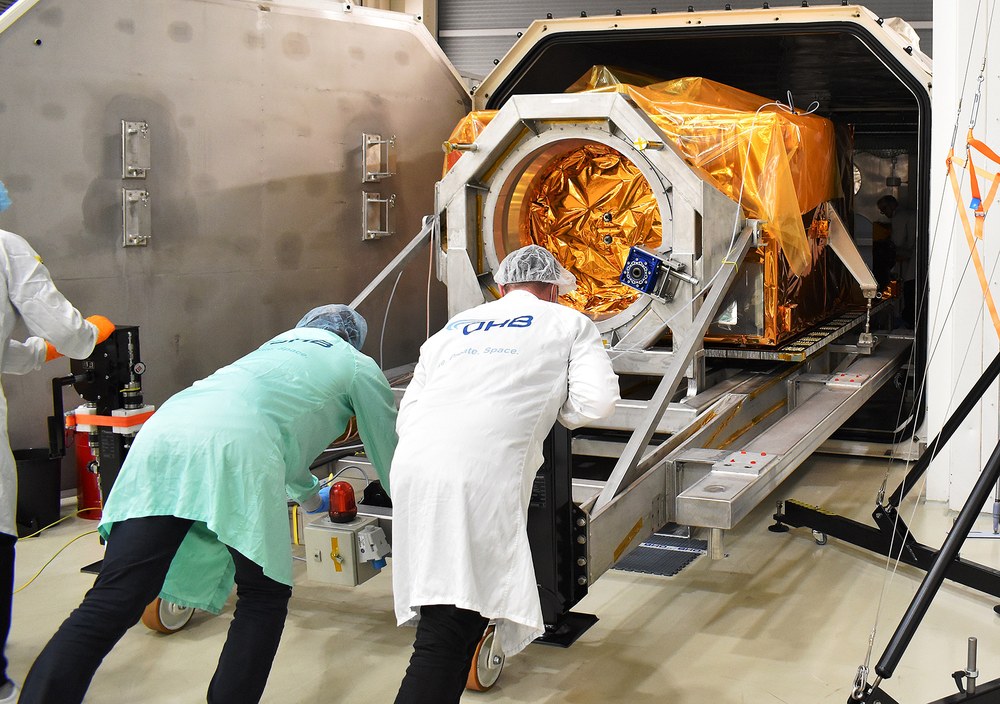To space from Bremen, via Hanover and Florida


- On 27 February 2022, at 13:05 local time (19:05 CET), the German environmental satellite EnMAP arrived in Florida.
- The mission is led by the German Space Agency at DLR in Bonn on behalf of the Federal Ministry for Economic Affairs and Climate Action (BMWK).
- The satellite and its hyperspectral instrument have been developed and constructed by OHB System AG, while the ground segment is being developed and operated by DLR in Oberpfaffenhofen. The German Research Centre for Geosciences in Potsdam (GFZ) is the scientific lead for the mission.
- Focus: Spaceflight, Earth observation, climate change, environmental protection and nature conservation
The Environmental Mapping and Analysis Program (EnMAP) satellite, the first hyperspectral satellite developed and built in Germany, landed safely at NASA's spaceport in Florida on 27 February 2022 at 13:05 local time (19:05 CET). It is now being prepared for flight and integrated onto a Falcon 9 rocket inside the hangar of the US space company SpaceX. EnMAP is expected to set off for its target orbit at the beginning of April 2022. The hyperspectral satellite is expected to collect data on the state of our home planet for at least five years. "We are very happy that EnMAP has now arrived safely in Florida. It was a great feeling to see the aircraft land collect the EnMAP satellite. Now we are taking big steps towards the launch," says Sebastian Fischer, EnMAP Mission Manager at the German Space Agency at DLR , who is on site in Florida.
It all started in the evening hours of 24 February 2022. At 21:00, two heavy transporters left the OHB System AG factory site in Bremen with a special container housing the satellite measuring 8.9 metres long by 2.8 metres high by 3.2 metres wide and another container full of test equipment. The destination of the EnMAP convoy was Hanover-Langenhagen Airport. The transport arrived at 00:00, at which point the container with the EnMAP satellite was loaded onto a transport aircraft. Following take-off at 16:00 on 25 February, it then travelled via Keflavik in southwest Iceland and Portsmouth International Airport at Pease in New Hampshire (USA) to the space shuttle runway at NASA's Kennedy Space Center. There, the satellite was unloaded from the container on 28 February 2022 and taken to SpaceX's integration hall, where it will be prepared for its journey atop a Falcon 9 rocket.

Trailer: Environmental satellite EnMAP is ready for use in space
Your consent to the storage of data ('cookies') is required for the playback of this video on Youtube.com. You can view and change your current data storage settings at any time under privacy.
New EnMAP video explains the mission
The German environmental mission EnMAP will improve our understanding of Earth's ecosystem. Walther Pelzer, DLR Executive Board member and Head of the German Space Agency at DLR, and Sebastian Fischer, EnMAP Mission Manager at the German Space Agency at DLR, together with the mission partners, explain exactly who the mission will support and how in our EnMAP video (German only) on the YouTube channel of the German Space Agency at DLR.
EnMAP – the German environmental mission and its partners
The EnMAP environmental mission is managed by the German Space Agency at DLR in Bonn on behalf of the Federal Ministry for Economic Affairs and Climate Action (BMWK). OHB System AG was commissioned to develop and build the satellite and its hyperspectral instrument. The German Research Centre for Geosciences (Deutsche GeoForschungsZentrum; GFZ) in Potsdam is the scientific lead for the study.
Three DLR institutes and facilities have been commissioned to set up and operate the ground segment. The German Space Operations Center in Oberpfaffenhofen will conduct and monitor satellite operations, while the German Remote Sensing Data Center and the DLR Remote Sensing Technology Institute will archive, process and validate the received satellite data and make them accessible to users in the scientific community. Companies and public authorities will also be able to view the data and use them to prepare future services. The use of EnMAP hyperspectral data by universities and scientific institutions and the development of special applications will be supported by BMWK funding programmes.

